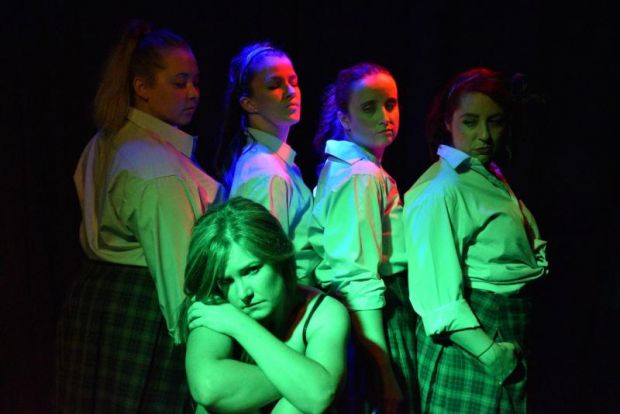What Is the Matter with Mary Jane? & Slut
The two one-act plays that make up this double bill depict conditions or the cruel prejudices that afflict (almost exclusively) women. In What Is the Matter with Mary Jane? it is anorexia nervosa and bulimia. In Slut, it is the misogyny and double standards (and jealousy?) that get a woman labelled ‘slut’. Both plays give rise to unfashionable emotions– in the current climate - since in both plays the persecutors on stage are other women.
Mary Jane tells of co-playwright Sancia Robinson’s own experience with anorexia nervosa, and it seeks to do this by dramatizing – both realistically and metaphorically - what it feels like to suffer this condition. Originally an autobiographical one-woman show, the play has been rewritten in collaboration with comedienne Wendy Harmer, and is here presented by three women and one man (Casey Bohan, Jen Bush, Izabella Perversi and Samuel Howard), showing, as the program note has it, ‘how this debilitating mental illness affects all kinds of people’. But the four actors also represent different aspects of the internal turmoil of ‘Sancia Robinson’, her persecutors, and the near schizophrenic voices she hears in her head, telling her she’s ‘fat’ (when she plainly isn’t), repulsive, weak, lazy, shameful, and pathetically failing to reach the impossible contemporary standards of ‘beauty’ and health as shown by super models and movie stars. Indeed, one of the funniest sequences here is Casey Bohan’s frenetic recounting of a super model’s ‘normal’ day.
In short, the character ‘Sancia Robinson’ has internalised every bit of the poisonous body image, body shaming negativity that assaults her. With the intention, no doubt, of making this uncomfortable subject entertaining, the tone and acting style here is that of bright, upbeat-but-ironic comedy – a writing and directing choice that comes to feel rather over-emphatic, somewhat forced and relentless. The cast plays the text at speed, overlapping and ‘echoing’ – which feels both an inappropriate choice by director Natasha Boyd, given the subject matter, and exhausting for the audience. Izabella Perversi has the clarity and presence to get away with it, but the rest can be over-ridden in the ‘all kinds of people [and voices]’ idea – and, with due respect to Samuel Howard, his role feels like a tack-on. There are some genuinely funny sequences – such as that super model riff – but there is also an overlong and graphic sequence that turns the experience of bulimia into a (metaphorical) television comedy show (in the style, say, of Get Krack! n) that nauseates and then wearies the audience. Okay, we get it!
What Is the Matter with Mary Jane? – the misleading title comes from an AA Milne poem – is undoubtedly a heartfelt plea for understanding and sympathy, but in the end, despite the efforts of the cast and director Ms Boyd, the result is a superficial treatment of anorexia nervosa, one that only in the last few moments acknowledges any kind of aetiology (even omitting family dynamics) for the condition – and even then, is vague, asking only for the rest of us be non-judgemental and for sufferers to seek treatment.

With the second play, the Patricia Cornelius piece, Slut, Ms Boyd’s direction and her ensemble cast (Casey Bohan, Jen Bush, Malaynee Hayden, Julia Lambert and, as the eponymous ‘slut’, ‘Lolita, Reschelle O’Connor) fare far better. The writing is simply superior. The text – originally a free verse play - is entirely suited to a sort of choric delivery. But each of the cast skilfully suggests an individuated ‘real’ person – from catty schoolgirl to judgemental adult – while being representative at the same time of a misogynist group-think society. The ‘characters’ are not abstractions and thus have great and dismaying force. By contrast to Mary Jane, Slut has a sly humour and dramatizes causes without ever being didactic – and, bravely, sheets home much of the misogyny to other women. Lolita herself scarcely says a word, but Reschelle O’Connor plays her beautifully as the naïf at the mercy of seeing herself only as others do.
The inspiration for this 2007 piece came from the media treatment of the ‘party girl stripper’ victim of a city shooting. Patricia Cornelius imagines her fictitious ‘Lolita’s’ life from schoolgirl (the pretty one who gets all the attention and then becomes addicted to the attention) through to the young woman who only exists in the gaze of men, to the corpse in an inner-city street. Throughout, Lolita is a focus of jealousy and confected contempt and her end evokes society’s reaction as not far away from ‘she got what she deserved’. Yet again, Cornelius takes a disregarded, non-respectable, only-to-be-avoided woman – in this case, a ‘slut’ - and forces us to look again. This is a powerful piece and superbly realised by director and cast.
Michael Brindley
P.S. The real Sancia Robinson came through this debilitating condition and is now a very good actress, plus a writer and producer.
Subscribe to our E-Newsletter, buy our latest print edition or find a Performing Arts book at Book Nook.
